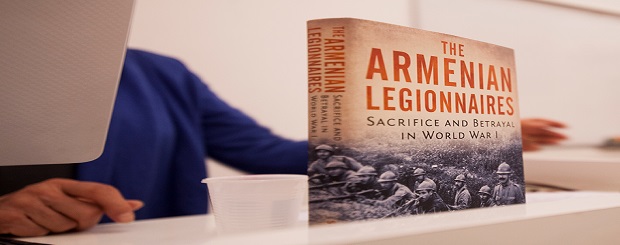
HISTORICAL DOCUMENTARY EVENT:
Suzanne Paul Patin, who has been working on the material for many years, has difficulty saying to say two, maybe three, maybe four or even a whole life. “Yes, a whole life, this is probably the right answer,” says Susan at a presentation at the American University of Armenia.
He takes a deep breath, comes to the computer, and shows the exclusive photos he has at hand during the presentation. Tigran Mansuryan enters the building. Looking at the writer, they smile and look at the center of the room, where the most important book of the day is laid on the table.
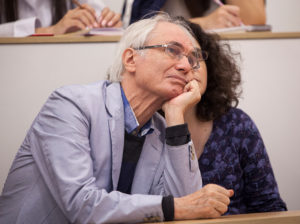
Tigran Mansuryan
Photo: Mediamax
Several Facts About Armenian Legion:
On October 27, 1916, President of the Armenian National Assembly, Paul Nubar, agreed with England and France about the creation of the Legion d’Orient, consisting of Armenian and Syrian volunteers, who had to fight against Turkey under France’s patronage. The allies promise to give autonomy to Cilicia..
From February 1916 until July, more than 1,200 Americans have joined Legion in America.
In August 1917, Armenian volunteers’ trainings began in Cyprus.
In June 1918, Armenian volunteers joined the allied forces in Palestine by the command of British General Edmund Elena.
On 19th September 1918, Legion defeated German and Turkish forces led by Mustafa Kemal at the Heights of Arara (Palestine).
From December 1918 to November 1919, British troops occupy Cilicia. Meanwhile, 120,000 Armenian refugees return to Cilicia, being convinced that they are under the protection of French and British troops.
On May 4, 1920, Armenians proclaimed the independence of Cilicia under the French mandate. In response, French officers start disarming the Armenian Legion.
On September 27, 1920, the Armenian Legion disarmament was over. Some volunteers remain in Cilicia to protect the Armenian population.
On October 20, 1921, France recognized the Kemalist Turkey and agreed to end its withdrawal from Cilicia. Armenians are killed or forcibly displaced.
The book
The Armenian Legionnaire is written: Sacrifice and Betrayal in World War I, “Armenian Legionaries. Sacrifice and betrayal in the First World War. ”
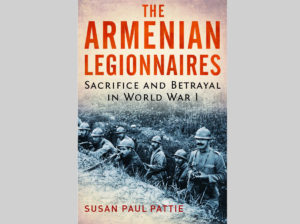
Photo: Mediamax
The book tells about the remarkable story of Armenian volunteers visiting Legion. People who had survived the Genocide, emigrated and returned to the battlefield to fight alongside allies. So they hoped to save their families, their compatriots and their homeland.
Those forces were small, but they played a major role.
The author also does not forget about women. From the time of study in Cyprus to the Middle East struggles, like the “red thread”, their history is stretching.
Suzanne Pot Pattin describes the dreams, goals and motivations of the Armenian legionnaires on pages 259.
The book contains eyewitness accounts, letters and unique photos, mostly from personal archives.
The book is sold in Amazon, it costs $ 35.
The writer
Susan Paul Patin is an Honorary Senior Researcher at the University College London, and is the former director of the Armenian Institute of London.
He speaks Armenian. He says, “It’s enough to formulate the most important thoughts.”
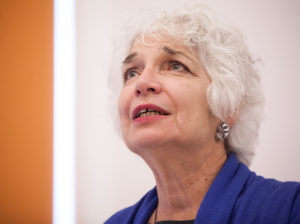
Suzanne Paul Patchy
Photo: Mediamax
Born in Washington, now lives in London. The roots are Armenian, and grandparents were born in Kessab, during the genocide years, they appeared in Pennsylvania, where their daughter, Susan’s mother was born.
In his London kitchen, Susan only cooks Armenian food, teaches, writes and tells about the Armenians and the Armenian Diaspora.
Promise:
He has never been interested in Armenian legionaries. It became an accident, an ordinary evening.
“I remembered everything I had heard in my childhood. I knew I had the luck to recognize a generation that was of utmost importance to our history. I realized I knew too much about them. I began to appreciate the historical value of my family and realized that I had to promise to myself that I would tell all that I had heard from them. ”
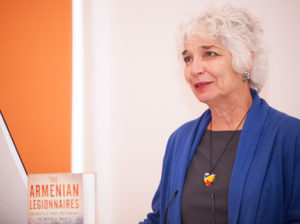
Suzanne Paul Patchy
Photo: Mediamax
Susan first wrote his memories, then checked the facts and found new stories. All of this was first turned into a research, and then a bold book.
Armenian Version:
The author has not yet received the offer to translate the book into Armenian. It does not even imagine it in Armenian yet, but considers that idea as a genius.
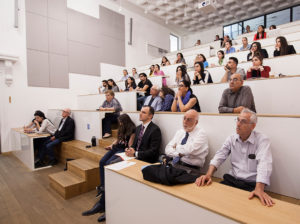
photo: Mediamax
“It is ridiculous, is not the book about Armenians, but only in English? Probably, we should work in that direction, “he says.
He promises to translate into Armenian, will be present at the presentation.
Lusine Mkrtchyan:
Photos by Emin Aristakesyan
ORIGINE SOURSES-mediamax.am/am/news/society/30557/
TRADUCTION ANGLAIS «lousavor avedis»
